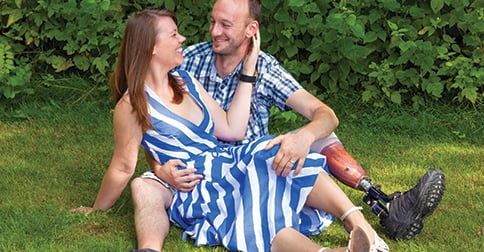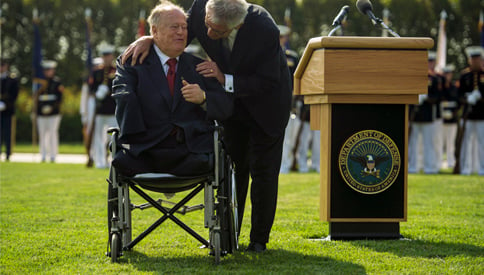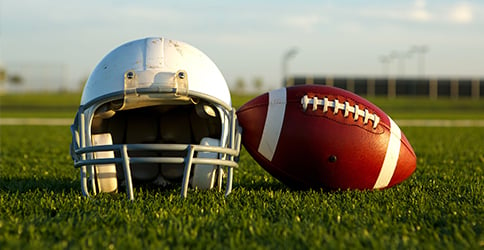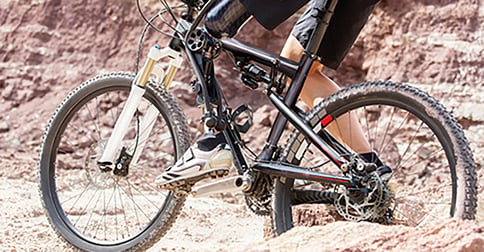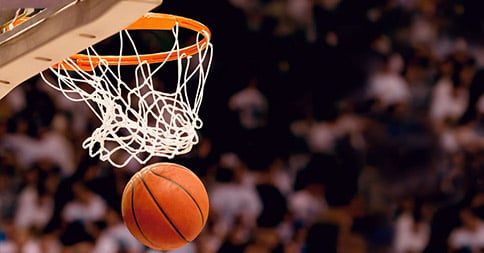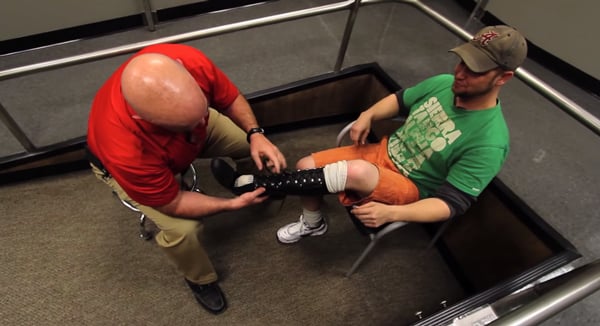Losing a limb can feel like a daunting setback. Even after you’ve physically recovered and learned to wear your new prosthesis, everything feels different and the learning curve looks huge. But if there’s one thing we’ve learned about limb loss, it’s that your perspective on the situation can make or break your ability to move forward and recognize all your possibilities.
Check out these tips for thankfulness as we approach Thanksgiving season!
Focus on What You Have
We’re not trying to minimize the circumstances that led to your limb loss – but you have a choice about what you focus on. Will you dwell on your losses, or will you zone in on the fact that your life is still full of purpose?
The choice you make can have a deep impact on your mental and emotional health for years to come, so it’s important to focus on the positives. Take inventory of everything you didn’t lose. Go over that list every day until thankfulness becomes instinctual. You’ll be amazed at the difference in your overall perspective!
Remember that Limb Loss Isn’t the End
The loss of a limb can feel like the loss of your favorite hobby, a beloved sport, or even your career. But it doesn’t have to be that way!
With all the technological developments in the field of prosthetics, and the way new industries like 3D printing are changing the affordability of prosthetic devices, maintaining your former lifestyle is much more possible than you may think. Whether you want to keep shooting hoops or you don’t want to give up globetrotting, chances are, there’s a prosthesis out there that can help you keep doing what you love.
Move Forward
Okay, so you’ve taken inventory of all the great things in your life and you’ve found a prosthesis that allows you to stick with your favorite activity or your job. What now?
You’ve already done the important part, which is to focus on the good and move into your new normal. Now, you’ve got to keep that momentum going! It’s common to have an off day every now and then, but as long as you’re aiming for a life of purpose and positivity, you’ll see a lot more fulfillment in your everyday activities.
Contact BioTech!
Here at BioTech, we’re passionate about helping you recognize all your possibilities after limb loss. You don’t stop – so neither do we! If you’re looking for a fitting or you just need some answers, BioTech is here for you. Contact us today!
We’ve talked a lot about athletes who have prosthetic devices, and it’s true – they are very inspiring! But since election season is upon us, we thought we’d take a moment to look at some politicians with limb loss who have led the world in spite of their setbacks. Read on!
#1: Ted Kennedy, Jr.
Edward Moore Kennedy, Jr. is the son of U.S. Senator Ted Kennedy and Virginia Joan Bennett. After the discovery of cancer in his right leg in 1973, Kennedy’s leg was amputated. He holds an undergraduate degree from Wesleyan University, a master's degree from Yale University, and a Juris Doctor degree from the University of Connecticut School of Law. An impressive list of accomplishments, indeed!
#2: Daniel Inouye
Daniel Ken Inouye was a recipient of the Medal of Honor. He served as the senior United States Senator from Hawaii until his death in 2012. He was a senator for more than forty years, which is something few senators can claim. After losing his arm in battle, he had to leave behind his plan to become a surgeon, instead returning to college to study political science on the GI Bill.
#3: Max Cleland
Joseph Maxwell Cleland is a former U.S. Senator and a disabled U.S. Army veteran of the Vietnam War. He attained the rank of Captain during his service, and he also received the Silver Star and the Bronze Star for his valorous action in combat. After picking up a grenade he thought had come off his flak jacket, the grenade detonated, shredding one arm and both his legs.
#4: Robert Kerrey
Joseph Robert "Bob" Kerrey served as Governor of Nebraska from 1983 to 1987. He was also the U.S. Senator from Nebraska from 1989 to 2001. Kerrey served as a SEAL in the United States Navy from 1966 to 1969 during the Vietnam War, at which time he lost the lower part of one leg in combat and was awarded the Medal of Honor.
Politicians with Limb Loss Are Just the Beginning...
Here at BioTech, we’re convinced that limb loss doesn’t have to stop you from achieving your dreams. Whether you want to be a politician or a basketball player, the right prosthetic device can help you get there. Contact us today for more information!
You might think it’s impossible for athletes with prosthetic devices to reach the same level of success as their whole-limbed colleagues, but that’s a myth. Limb loss can be overcome on the playing field – and these football players are here to prove it!
#1: Deven Jackson
A few years ago, Deven – now 12 years old – lost both his legs to meningitis. He never wavered in his goal to return to football, even spending 3 hours a week learning to walk and run with his new blades. Plus, he got to meet some of his favorite pro football players as a result of his endurance and positive attitude!
#2: Damon Hodges
As a baby, Damon had twisted feet. Both of them were amputated when he was 2 years old. You wouldn’t think that would make for a very promising football career, but Damon has shown the world otherwise! He’s now playing varsity football for his senior year of high school, and he says that “anything you put your mind to, you can do it.”
#3: Andrew Kittrell
Born with Amniotic Band Syndrome, Andrew lost his left leg below the knee and has a right club foot. The fingers on both of his hands are also affected. All of this resulted in 7 surgeries before Andrew’s 12th birthday. Andrew, now a high school sophomore, doesn’t let any of this stop him – and he thinks it’s pretty funny when his leg comes off during a tackle.
Their Inspiration Is Our Motivation
Here at BioTech, we think people with limb loss are pretty awesome. That’s why we do everything we can to give our patients exceptional service, from expedited fittings to advice on cost and insurance.
Whether you’re looking for prosthetic or orthotic devices, scoliosis braces, or just a friendly face and a positive attitude, BioTech is the place for you. We’ll treat you like family – guaranteed.
Are you ready to experience BioTech? Contact us today!
Cycling is a fun, low-impact exercise that can help you rebuild strength and maintain your fitness after losing a leg. But if you’ve had an above or below knee amputation, how do you continue to ride your bike?
Read on for tips!
The Bicycle
One of the most common problems associated with cycling after amputation is that a prosthesis doesn’t stay on a flat pedal very well. Instead, it will slide off, which makes riding a bike very difficult.
As you’re starting to get back into cycling, the best thing to do is to have a flat pedal without clip-ins on the side with your whole leg (for single amputees) while you get used to clipping in on the side with the prosthesis. Sometimes, a clip-in pedal allows for tension adjustment, which will make it harder or easier to unclip. Make sure you set this on the easiest position.
Also, a crank arm shortener may help decrease the degree that your knee has to bend, which can make things a lot more comfortable and efficient for you. Crank arm shorteners allow you to place the pedal in a variety of locations so that you can find the best position and, hopefully, reduce the amount of socket pinch behind the knee or at the hip. You can find a crank arm shortener online or at your local bike shop.
The Prosthesis
Another issue that comes with cycling after amputation is that the heel of your prosthesis may hit the crank arm. If that happens, the first thing to try is asking your prosthetist to help you adjust your alignment when getting on and off the bike.
For an above the knee socket, you can also see about having an older socket cut down to give you more comfort on the bicycle seat. Using a waist belt can help by giving you improved rotation control and suspension.
Some knee prostheses have a “free swing” setting, which can make pedaling much more efficient. Just make sure you know how to change the setting as you get on and off the bike.
Getting On and Off Your Bike
You’ve prepared your bike and your prosthesis -- you’re ready to go! Well, almost. First, make sure you are adept at getting on and off the bike. This needs to be a smooth process that you feel comfortable with before you take off down the road. Have someone spot you until you’ve got the hang of it.
The best way to get on your bike is to swing your prosthetic side (or your weaker side, if you are a double amputee) over the bike and then secure it into the pedal. To get off the bike, set down your sound leg (or your stronger side) first. You’ll have to twist a bit to unclip your prosthesis from the pedal; sometimes it helps to lean the bike over a little after setting your sound foot on the ground.
Once you feel confident getting on and off your bike, you’re ready to take your first ride! Just be careful and exercise good judgment. Start slow, and go out for a short time. You can increase your time and speed little by little until you build up to your desired level. Soon, cycling after amputation will feel natural, and you’ll be spinning down the street whenever you want!
BioTech Can Help You Get There!
Here at BioTech, our passionate, dedicated team is here to help you reach all your athletic goals. We know the possibilities, and we are here to make them your reality! Contact us today for all your prosthetic and orthotic needs.
We’ve mentioned before how technology in the field of prosthetics has come a long way, and how it is only gaining speed. When it comes to professional sports, there are some sectors -- like track and field -- that have already realized their prosthetic potential, and there are others -- like basketball -- that are on the verge of doing so.
Pistorius’s Flex Foot Cheetah Blades
Why are we bringing up Oscar Pistorius in a basketball article? Bear with us -- it’ll make sense in a minute.
We know he’s a controversial figure, but if we can look at Oscar Pistorius solely for his athletic ability, we find someone who became a dominant athlete in spite of having both legs amputated as an infant. By the time he was 18 years old, he was a Paralympic gold medal winner in track, and was beginning to compete in races in his native South Africa with people who were not amputees.
How was this possible? How could a man with two amputated legs compete with whole-legged men? According to a study done by the International Association of Athletics Federations (IAAF), "The positive work, or returned energy, from the prosthetic blade is close to three times higher than with the human ankle joint in maximum sprinting."
What This Could Mean for Basketball
Imagine if the technology in Pistorius’s Cheetah blade could be adapted for the basketball court. You could have a durable leg prosthesis with a smart microprocessor that doesn’t get nearly as weary as a natural leg because the returned energy would be so much higher.
And a leg that doesn’t get as weary means a player that doesn’t get as weary -- and that might sound pretty good to the NBA, which is more attuned to the wear and tear of its athletes than ever before.
What Are the Challenges?
As opposed to something like track, which is essentially a single motion sport, there are myriad biomechanical demands when it comes to basketball. Think directional changes, lateral movements, sudden stops and starts, and so on. And that’s not even considering what has to happen for an athlete to shoot the ball or get a rebound -- both of which require a very specific and complicated set of movements in the upper body.
This combination of movements in basketball is the greatest challenge to developing a prosthetic device for the players that would perform at the same level as the Cheetah blade. But the technology is on the horizon, and the science backing it up is advancing quickly.
We’ll never be able to fully replace a natural limb. But it is possible to get close -- and if technology keeps moving the way it has been, the NBA could look very different in just a few years.
BioTech Is Here for All Your Athletic Needs
No matter your lifestyle, BioTech has what you need. We work with each patient one-on-one to get the best fit possible, and we won’t stop until you are completely satisfied. Contact us today for more information!
Chad Bailey’s life was changed 12 years ago when he lost his foot from the heel forward. He sought an orthotic device that would give him a comfort fit and make him feel like he had his foot again. Instead, he received a brace that was made of solid plastic and hurt so much that he couldn’t effectively use it.
Then Chad turned to BioTech, which built the second brace. Chad has been using the brace that BioTech created for him for 10 years now and says he couldn’t ask for anything better!
What was the difference? BioTech uses cutting edge technology to custom fabricate each piece for the individual.
BioTech Uses Carbon Technology
Eric says that the key to creating the perfect brace for Chad was BioTech’s use of carbon technology. The company is taking technology that was previously only available for prosthetics and they are applying it to orthotics.
Chad’s brace was created in BioTech’s own carbon laboratory in Birmingham, Alabama. Most prosthetic and orthotic facilities don’t have a carbon laboratory, but BioTech has this technology in house to ensure quality and a perfect fit for our clients.
We used a unique application of pre-impregnated carbons that give the brace energy storing capability. The carbon is laid up to suit the individual based on their height, weight, and activity level. BioTech’s carbon technology has given Chad the toe spring to make him feel like he’s got his foot back!
Customer Satisfaction is our Goal
At BioTech, our customers are like family. We want them to be able to achieve anything they want to accomplish and we will do everything in our power to help them along the way!
When asked about his experience with BioTech, Chad smiles and says,”It’s wonderful. They do a great job here.”
Are You Ready to Experience a Custom Fit Created Just for You?
Purchasing a prosthesis or orthoses shouldn’t be like buying clothes. There is no “off the rack” solution. At BioTech, your comfort and ability are our number one priority.
If you are ready to experience the comfort that comes from having a custom piece created just for you, contact BioTech today. We want you to help you achieve your possibilities!
Hear Lee George's story and how he turned to BioTech Limb and Brace for a custom prosthesis that allows him to ride his motorcycle!
Not long ago, Lee George received a report from one of his crews in the field. They were performing electrical work outside and needed him to take a look at a problem.
Lee arrived at the scene, went up in a bucket truck, and scoped out the problem. It didn’t take long before the situation was handled.
Stepping back to take a look at the scene, Lee had something happen to him – and it changed his life.
Within a split second, 13,000 volts of electricity went through Lee’s body from a hot ground wire. The jolt not only sent life-threatening amounts of electricity through his body; it also severely burned him. By the time he had been treated to medical care at the hospital, he had received third-degree burns over 50 percent of his body – resulting in the loss of two fingers on his right hand, a six-inch hole in his skull, and the complete loss of his entire left arm.
It’s difficult to recover from such a tragic and sudden circumstance like that. But while doctors were worrying about his chances of survival, Lee was worrying about something else – how he would be able to ride his beloved motorcycle. (It’s in his blood; his family owned the first Harley-Davidson dealership in the state of Alabama.)
After his 197-day stay in the trauma ICU, we were able to help Lee in his quest to get back in the saddle by outfitting him with a state-of-the-art prosthesis – the i-limb ultra revolution - to replace his left arm. This prosthesis allows him to do much of what he did before, made possible by the technology in the piece – including individual motors in each digit that enable different grip patterns to help him in a variety of situations.
With his prosthesis, Lee can carry on living his life, including driving his motorcycle wherever he pleases.
That’s exactly what Lee recommends to other people in his situation who have lost limbs and are faced with the task and trial of living life after a challenge. He says, “You have to stay active and carry on with your life” doing the things you love to do, no matter what.
At BioTech, those are the possibilities we love to help create.
Check out Lee’s video for more about his story, and contact BioTech for a consultation about you or a loved one.
(Oh, and be sure to wave to Lee if you see on him the road with his chopper.)
Noah Galloway has inspired the entire nation on Dancing with the Stars over the last few weeks. Take a minute to learn more about Noah's story, including how he became a double amputee.
When Noah went to Iraq, he "never imagined that it was possible to wake up one day and be a double amputee." After 9/11, he the country was going to war and he wanted to be part of that.
After a roadside bomb led to him losing his arm and leg, Noah realized that he could overcome everything, thanks to the amazing support he had that he knew would be essential to his recovery.
Noah is truly an inspiration to everyone, amputees and non-amputees alike! He is determined and one of the most incredible people you will ever meet.
Noah is incredibly excited "to be wearing an arm again." Check out the most recent video of Noah talking a little bit about his arm fitting for Dancing with the Stars!
Below is another video about Noah's experiences.
Today, he is stronger than ever and "feels at home" when he's challenged.
Make sure you watch Noah on Dancing with the Stars and cast your vote for #TeamShway!
Learn more about recognizing your possibilities with BioTech Limb & Brace. Contact us today!
Rich Mixon is a kitchen designer with Lowes. He is now pain free and planning to run a half marathon!
Rich was originally hurt playing peewee football when he was only 13-years-old. He has had 19 surgeries and 4 total knee replacements from the time he was 14. His doctor recommended him to BioTech.
Rich decided to have the amputation surgery after talking with Eric at BioTech. Before amputation, Rich spent many years unable to function due to the pain in his leg. Once the pain was gone, he has been able to do things that Rich was unable to do with his own leg.
"The guy you see today is a happy person, he works pain-free," says Eric about Rich's new life.
He works 12 hours per day, wears his leg 16-18 hours per day, and is no longer on pain medication. He plans to run a half marathon in June of this year and BioTech is working with the VA to help Rich get a new running leg.
"My quality of life is probably 110% better than it was to begin with," says Rich. He is excited because he is no longer on pain medication.
Learn more about recognizing your possibilities with BioTech Limb & Brace. Contact BioTech today!
